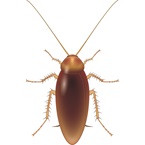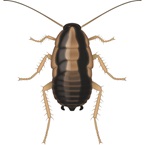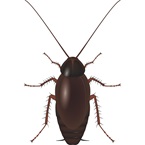Order: Dictyoptera (‘net-winged’)
Family: Blattidae
German Cockroach:
12mm long
CHARACTERISTICS:
Generally two pairs of wings, although these may be reduced or even absent; forewings have well developed veins and tend to be hardened, they overlap down the mid-dorsal line; membranous hindwings are folded below forewings; long whip-like, many-segmented antennae; omnivorous, with mouth parts adapted for biting; tarsi, 5-segmented; incomplete metamorphosis, with egg and nymph stages.
SPECIES CHARACTERISTICS:
German Cockroach (Blattella germanica)
Adult, 10-15mm long; colour, yellowish-brown with two longitudinal dark marks on pronotum; wings well developed in both sexes; can readily climb rough and polished vertical surfaces.
Nymphs
The nymphs of all species are similar in appearance to the adult but smaller. Immediately after hatching or moulting the nymphs are white, but the cuticle soon darkens to the normal colour.
AREAS WHERE FOUND:
Cockroaches are common in commercial premises associated with the production or handling of food. Also in public buildings and domestic premises eg apartment blocks. Gregarious and nocturnal, they spend the day hiding in cracks and crevices around such areas as sinks, drains, cookers, the backs of cupboards and in refrigerator motor compartments. They especially favour buildings with service ducts and complex plumbing installations. Infestations may be introduced as egg cases or adults in incoming laundry, on raw materials, in crates and packaging, or arise as the insects enter buildings via such routes as drains or refuse chutes. B. orientalis and B. germanica are the most common species in South Africa. They are occasionally found together, but B. germanica generally prefers warmer, humid environments, e.g. centrally heated buildings, whilst B. orientalis is frequently encountered in cooler, less humid areas such as basements and drains. P. americana is a tropical species but is also found in ports and shipping areas in temperate climates.
IMPORTANCE AS A PEST:
Cockroaches are potential vectors of diseases such as dysentery, gastroenteritis, typhoid and poliomyelitis. Their diet is omnivorous and includes fermenting substances, soiled septic dressings, hair, leather, parchment, wallpaper, faeces and food for human consumption. The latter may be contaminated either by the mechanical transfer of causative agents of disease from the insect’s body, or by transmission in the faeces. An outbreak of food poisoning in a Brussels hospital subsided immediately an infestation of B. germanica was controlled. Cockroaches and their faeces may cause allergic reactions especially amongst sensitive individuals eg asthmatics. Exposure may result from ingestion or through the inhalation of materials derived from cockroaches in airborne dust. In addition, food may be tainted with the characteristic smell of the cockroach, which is produced by faeces and salivary/abdominal gland secretions, or by the dead insects.
LIFE-CYCLE:
German Cockroach
The female of this species produces 4-8 egg capsules at approximately 1 month intervals.
Each thick-walled resistant capsule is 6mm long and contains up to 30 eggs, but unlike B. orientalis, the female carries the capsule until just before the eggs hatch - some 2.5-4 weeks later. Efforts are made to conceal the capsules near a food source, where the nymphs will hatch and pass through 5-7 moults before reaching maturity. At a temperature of 25°C maturity is reached in 3.5 months, but this time can be profoundly influenced by temperature. Adults live approximately 8.5 months at 25°C. The German cockroach is particularly successful for the following reasons:
- A large number of eggs per capsule;
- The female protects the egg capsule, by carrying it until just before hatching;
- Short development period to hatching and maturity;
- Small size, therefore readily conceals itself.
CONTROL:
Successful control of cockroaches is a complex subject, and depends very much upon tailoring control measures to the species concerned.
Assessment of infestations
An assessment of the infestation must be made to determine the species and extent of the infestation. Plans of the area will be required. The entire site should be inspected, including where appropriate adjoining premises, normally inaccessible places, drains etc. A night survey is useful as this is the time of maximum insect activity. The survey may be carried out using cockroach monitoring traps, searching for droppings, cast skins and egg cases etc. A pyrethroid-based aerosol sprayed around and into potential hiding places will flush out cockroaches (other than the Oriental cockroach).
Control measures
- Hygiene/management:
A high standard of hygiene is important in the control of cockroaches and involves the following components:
Deny access to food and water. This will increase cockroach activity and directed movement improving the opportunity for the insects to encounter insecticides. Deny access to harbourages in buildings or equipment which would otherwise provide hiding places, a means of gaining access and dispersing and breeding sites. Ease of cleaning. Buildings and equipment should be designed to minimise the accumulation of debris and facilitate ease of cleaning. Surveillance of incoming materials including packaging and laundry. Environmental controls eg. ventilation which will accelerate dehydration of the insects and interfere with the operation of antennal chemoreceptors.
- Insecticidal control:
Surface sprays: Effective treatment depends upon the selection and thorough application of a suitable insecticide. Many insects and egg cases are well hidden; therefore, the insecticide must be placed at and around these harbourages and maintained over the developmental period of the particular species. To control an infestation the insecticide should ideally persist until all egg cases have hatched but continued immigration may demand routine treatments.
Space spray: Regular treatments are necessary eg at weekly intervals until the infestation is brought under control. Thereafter, maintenance treatments, at less frequent intervals, should keep the insect population at an acceptable level. Initially there will be a massive kill of adults and nymphs resulting in only the appearance of young nymphs from time to time. The technique is particularly useful using pyrethroid insecticides to flush cockroaches from their harbourages and over surface deposits of insecticide.
Insecticidal baits: Baits (see recommended products) offer the opportunity for controlled placement of insecticides formulated in attractive food bases. When placed in areas infested with cockroaches the insects feed on the baits picking up a lethal dose of insecticide in the process. Baits offer the opportunity for continuous control of cockroaches over extended periods. They can be integrated with surface or space spray treatments.
GLOSSARY OF TERMS:
Cerci: Paired appendages located at the tip of the abdomen. Pronotum: Dorsal surface of first thoracic segment. Tarsus (Tarsi): Apical section of leg (the foot).



